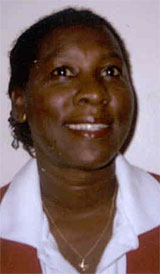Skimpy skirts, sponsors and over-arm bowling
Despite a certain paternalism at work, a slow but sure paradigm shift is occurring in West Indies women's cricket
Vaneisa Baksh
06-Sep-2005
|
|

|
Despite a certain paternalism at work, a slow but sure paradigm shift is occurring
in West Indies women's cricket. Women cricketers are now edging closer to the
advantages their male counterparts cherish as a birthright. Last August, at the
annual general meeting of the West Indies Cricket Board (WICB), the directors
accepted the proposal of the Integration Steering Committee (ISC) to appoint a
Cricket Committee to supervise women's cricket under the aegis of the parent body.
The integration process has been a long drawn one, and is still not quite the merger
mandated by the International Cricket Council when it completed its own exercise
with the International Women's Cricket Council earlier this year. By 2006 the WICB
and the women's wing ought to be fully united.
After proposals from Ernst & Young that the West Indies Women's Cricket Federation
(WIWCF) be made the seventh member of the WICB were discarded, an Integration
Steering Committee (ISC) was formed under the chairmanship of WICB vice president,
Val Banks. Finally, at the annual general body meeting, the proposal for a Cricket
Committee to supervise women's cricket was accepted.
The annual regional tournament held in St. Vincent last month, which Trinidad and
Tobago won, was the first venture of the Cricket Committee. The funding hasn't come
from the WICB though: the WIWCF was merely part of the WICB's marketing committee
and, in effect, had to fend for itself. In fact, funding has been an extremely
onerous burden for the WIWCF -- the team almost couldn't attend the World Cup in
South Africa.
Indeed, going by the slow and painful progress women's cricket has made, one cannot
but attribute it to certain entrenched attitudes. Whispered innuendos that our women
in white should be dressed up (or down) are attaining the status of strategic
advice. That is, where luring sponsors and spectators to, admittedly, the less
aggressive but, certainly, the no-less graceful version of the gentlemen's game is
concerned.
Such nuggets of wisdom betray ignorance of what women have contributed to cricket.
Were it not for Christine Willes who invented over-arm bowling in 1805, it is
debateable if the game would have benefited from the subsequent spectacles that the
legendary spin-meisters or monstering quicks have provided in the men's arena.
Similarly, few know or care to remember, that the first women's cricket World Cup in
1973 preceded the men's by two years. Women have actually been playing the game for
more than 500 years and the first recorded match in Britain was in 1745, 260 years
ago.
However, of late, there are powerful voices trying to disperse the gloom. Michael
Seepersaud, chief cricket development officer at the WICB speaks of the need for a
paradigm shift and of treating women's cricket not as an appendage but an integral
part of Caribbean cricket. "There were very few women coaches, umpires and scorers.
Yet female teachers dominate our school system and women are making significant
inroads in other sports and in all walks of life. If West Indies cricket is to
regain its rightful place at the pinnacle of world cricket, we have to deal with
these paradigm shifts," he argues.
And such change in perspective is being reflected on the ground. "I am quite pleased
with it. Around the Caribbean, most of the women's organisations are pleased that
the integration has come about. We need to make sure that women's cricket continues
to grow," said Ann Brown-John yesterday.
Brown-John has been around women's cricket for many years, earlier as captain of the
West Indies women's team, now as coach. As a member of the WIWCF, she knows
first-hand how uphill it has been for female payers, especially in terms of
sponsorship, development programmes and training facilities. She remains stoic and
committed though.
This year's junior tournament is the next item on the Cricket Committee's agenda,
while the ISC will continue its efforts to broaden the membership of women's
associations from the current seven to all Caribbean countries by June 2006.
From my own eight-year campaign to persuade the Queen's Park Cricket Club to
exclusive female membership, I am aware of what the odds are. But I am aware, too,
of the positives: of, how given half a chance in terms of access to training and
development, what the women in white in West Indies can deliver.
Vaneisa Baksh is a freelance journalist based in Trinidad

